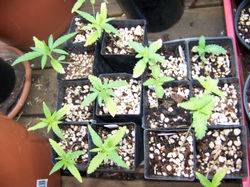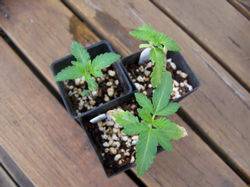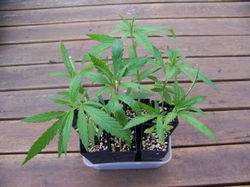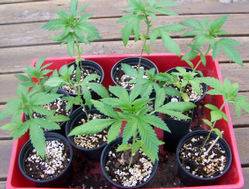High there 
This thread is dedicated to the ancient practice of adding charcoal to soil. This is being discussed in the Organic Fanatic Collective but i feel the subject deserves its own wee spot...
Wikipedia puts it like this:
Terra preta (which means "dark soil" in Portuguese) refers to expanses of very dark soils found in the Amazon Basin. It is also known as "Amazonian dark earth" or "Indian black earth". In Portuguese its full name is Terra preta do indio or Terra preta de indio.
Terra preta is distinguished from terra comum, or "common soil", which refers to the reddish or yellowish ferralsols that predominate under tropical soils. The soil is believed to be the result of past indigenous activities in the forest and is thus considered to be anthropic and/or anthropogenic, possibly from a pre-Columbian civilization.
Terra preta consists of low temperature charcoal, pottery shards, plant residues, animal faeces, fish bones, and perhaps some biological agent like a special ecosystem of healthy microorganisms. As it is very rich in nutrients to this day local farmers and caboclos in Amazonian basin seek it out for use as compost.
Origin of Terra preta
For a long time, the origins of the Amazonian dark earths were not immediately clear and several theories were considered. One idea was that they resulted from ashfall from volcanoes in the Andes, since they occur more frequently on the brows of higher terraces. Another theory considered formation as a result of sedimentation in Tertiary lakes or in recent ponds.
However, because of their elevated charcoal content and the common presence of pottery remains, it is now widely accepted that these soils are a product of indigenous soil management involving a labor intensive technique termed slash-and-char. The technique is differentiated from slash and burn by a lower temperature burn and in being a tool for soil improvement. Amending soil with low temperature charcoal produced from a mix of wood and leafy biomass (termed biochar) has been observed to increase the activity of arbuscular mycorrhizal fungi. It is theorized that terra preta self-propagates via this mechanism; a virtuous cycle established as the fungus spreads from the charcoal, fixing additional carbon and stabilizing the soil with glomalin, and increasing nutrient availability for nearby plants. The widespread peregrine earthworm Pontoscolex corethrurus (Oligochaeta: Glossoscolecidae), which thrives after burning of the rainforest, due to its tolerance of a low content of the soil in organic matter, has been shown to ingest pieces of charcoal and to mix them in a finely ground form with the mineral soil, pointing to its possible role in the formation of terra preta.
About 10% of the original terra comum appears to have converted to terra preta. Whether all Amazonian dark earth was intentionally created for soil improvement or whether the lightest variants are a by-product of habitation is not clear at present time. This is in part due to the varied features of the dark earths throughout the Amazon Basin. Thus suggesting the existence of an extensive ancient native civilization dating back 500 to 2500 years bp.
Product of an advanced pre-Columbian civilization?
The Spanish explorer Francisco de Orellana, the 16th C explorer who was the first European to transverse the Amazon River, reported densely populated regions running hundreds of kilometers along the river, suggesting population levels exceeding even those of today. The only reason this population left no lasting monuments was simply that they happened to use local wood as their construction material, which unfortunately rotted in the humid climate. (Stone was unavailable.) While it is possible Orellana may have exaggerated the level of development among the Amazonians, their semi-nomadic descendants have the odd distinction among tribal indigenous societies of a hereditary, yet landless, aristocracy, a historical anomaly for a society without a sedentary, agrarian culture. This suggests they were once more settled and agrarian but after the demographic collapse of the 16th and 17th century due to European introduced diseases they reverted to less complex modes of existence but maintained certain traditions. Moreover, many indigenous people were forced to adapt to a more mobile lifestyle in order to protect themselves against colonialism. This might have made the benefits of terra preta, such as its self-renewing capacity, less attractive — farmers would not have been able to enjoy the use of renewed soil because they would have been forced to move for safety. Slash-and-burn might have been an adaptation to these conditions.
This stuff is found in the Amazonian basin today and reportedly still very fertile. This just blows me away... i think its the final piece of the puzzle for all organic growers.
I am going to document my latest grow with a batch of beans i recently received from Seeds Boutique.
I mixed up a batch of charcoal using a recipe from Gardening Australia:
http://www.abc.net.au/gardening/video/default.htm?url=clips/petes_patch_ep37_2007.htm
The recipe:
Use one third of a standard bucket of pulverised wood charcoal
Half a cup of fish emulsion, half a cup of seaweed concentrate and 4 teaspoons of mixed, soluble trace elements all dissolved into 2-3 litres of water in a separate bucket to make a strong, nutrient concentrate.
Method:
1 Place the charcoal safely in a strong bag. Moisten a little for safety reasons. Use a hammer or similar implement to crush and pulverise it into a fine dust. Then place the dust into an extra-large bucket. Avoid inhaling the dust – you might wear a protective face mask or respirator.
2 Pour the fertiliser-based nutrient concentrate into the charcoal dust. Leave to soak for 3 days.
3 Then add one third of a bucketful each of dry river (pit) sand and ordinary soil (not clay). Mix together thoroughly.
4 Don’t use a stronger mixture than suggested.
Now it does say not to make it stronger but i figured this is weed and added an extra half cup of Indonesian bat guano for extra P
I soaked just over a third of a bucket of wood charcoal with a half cup each of Seasol (kelp), Powerfeed (fish emulsion), Indo bat guano, 4 tsp Azomite and drop of Superthrive in 5 litres water. I left this overnight and mixed with equal amounts sand and soil. I then made a mix of 1/3 coco, 1/3 perlite and 1/3 soil.
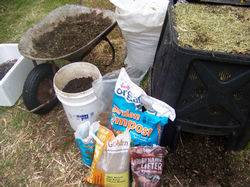
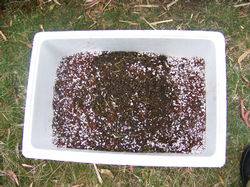
Thats my charcoal mix there in the white bucket. It has a smell of rotting seaweed.
EDIT: Heres some of the most useful links i have found for the home gardener
http://www.holon.se/folke/carbon/simplechar/simplechar.shtml
http://terrapreta.bioenergylists.org/
http://terrapreta.bioenergylists.org/content/biochar-retort-vs-pit-trials-ahualoa-hawaii
I especially like the look of this brick fire pit, perfect example of KISS. Looks like a very efficient production that can be sized up or down depending on your needs and space

This thread is dedicated to the ancient practice of adding charcoal to soil. This is being discussed in the Organic Fanatic Collective but i feel the subject deserves its own wee spot...
Wikipedia puts it like this:
Terra preta (which means "dark soil" in Portuguese) refers to expanses of very dark soils found in the Amazon Basin. It is also known as "Amazonian dark earth" or "Indian black earth". In Portuguese its full name is Terra preta do indio or Terra preta de indio.
Terra preta is distinguished from terra comum, or "common soil", which refers to the reddish or yellowish ferralsols that predominate under tropical soils. The soil is believed to be the result of past indigenous activities in the forest and is thus considered to be anthropic and/or anthropogenic, possibly from a pre-Columbian civilization.
Terra preta consists of low temperature charcoal, pottery shards, plant residues, animal faeces, fish bones, and perhaps some biological agent like a special ecosystem of healthy microorganisms. As it is very rich in nutrients to this day local farmers and caboclos in Amazonian basin seek it out for use as compost.
Origin of Terra preta
For a long time, the origins of the Amazonian dark earths were not immediately clear and several theories were considered. One idea was that they resulted from ashfall from volcanoes in the Andes, since they occur more frequently on the brows of higher terraces. Another theory considered formation as a result of sedimentation in Tertiary lakes or in recent ponds.
However, because of their elevated charcoal content and the common presence of pottery remains, it is now widely accepted that these soils are a product of indigenous soil management involving a labor intensive technique termed slash-and-char. The technique is differentiated from slash and burn by a lower temperature burn and in being a tool for soil improvement. Amending soil with low temperature charcoal produced from a mix of wood and leafy biomass (termed biochar) has been observed to increase the activity of arbuscular mycorrhizal fungi. It is theorized that terra preta self-propagates via this mechanism; a virtuous cycle established as the fungus spreads from the charcoal, fixing additional carbon and stabilizing the soil with glomalin, and increasing nutrient availability for nearby plants. The widespread peregrine earthworm Pontoscolex corethrurus (Oligochaeta: Glossoscolecidae), which thrives after burning of the rainforest, due to its tolerance of a low content of the soil in organic matter, has been shown to ingest pieces of charcoal and to mix them in a finely ground form with the mineral soil, pointing to its possible role in the formation of terra preta.
About 10% of the original terra comum appears to have converted to terra preta. Whether all Amazonian dark earth was intentionally created for soil improvement or whether the lightest variants are a by-product of habitation is not clear at present time. This is in part due to the varied features of the dark earths throughout the Amazon Basin. Thus suggesting the existence of an extensive ancient native civilization dating back 500 to 2500 years bp.
Product of an advanced pre-Columbian civilization?
The Spanish explorer Francisco de Orellana, the 16th C explorer who was the first European to transverse the Amazon River, reported densely populated regions running hundreds of kilometers along the river, suggesting population levels exceeding even those of today. The only reason this population left no lasting monuments was simply that they happened to use local wood as their construction material, which unfortunately rotted in the humid climate. (Stone was unavailable.) While it is possible Orellana may have exaggerated the level of development among the Amazonians, their semi-nomadic descendants have the odd distinction among tribal indigenous societies of a hereditary, yet landless, aristocracy, a historical anomaly for a society without a sedentary, agrarian culture. This suggests they were once more settled and agrarian but after the demographic collapse of the 16th and 17th century due to European introduced diseases they reverted to less complex modes of existence but maintained certain traditions. Moreover, many indigenous people were forced to adapt to a more mobile lifestyle in order to protect themselves against colonialism. This might have made the benefits of terra preta, such as its self-renewing capacity, less attractive — farmers would not have been able to enjoy the use of renewed soil because they would have been forced to move for safety. Slash-and-burn might have been an adaptation to these conditions.
This stuff is found in the Amazonian basin today and reportedly still very fertile. This just blows me away... i think its the final piece of the puzzle for all organic growers.
I am going to document my latest grow with a batch of beans i recently received from Seeds Boutique.
I mixed up a batch of charcoal using a recipe from Gardening Australia:
http://www.abc.net.au/gardening/video/default.htm?url=clips/petes_patch_ep37_2007.htm
The recipe:
Use one third of a standard bucket of pulverised wood charcoal
Half a cup of fish emulsion, half a cup of seaweed concentrate and 4 teaspoons of mixed, soluble trace elements all dissolved into 2-3 litres of water in a separate bucket to make a strong, nutrient concentrate.
Method:
1 Place the charcoal safely in a strong bag. Moisten a little for safety reasons. Use a hammer or similar implement to crush and pulverise it into a fine dust. Then place the dust into an extra-large bucket. Avoid inhaling the dust – you might wear a protective face mask or respirator.
2 Pour the fertiliser-based nutrient concentrate into the charcoal dust. Leave to soak for 3 days.
3 Then add one third of a bucketful each of dry river (pit) sand and ordinary soil (not clay). Mix together thoroughly.
4 Don’t use a stronger mixture than suggested.
Now it does say not to make it stronger but i figured this is weed and added an extra half cup of Indonesian bat guano for extra P

I soaked just over a third of a bucket of wood charcoal with a half cup each of Seasol (kelp), Powerfeed (fish emulsion), Indo bat guano, 4 tsp Azomite and drop of Superthrive in 5 litres water. I left this overnight and mixed with equal amounts sand and soil. I then made a mix of 1/3 coco, 1/3 perlite and 1/3 soil.


Thats my charcoal mix there in the white bucket. It has a smell of rotting seaweed.
EDIT: Heres some of the most useful links i have found for the home gardener
http://www.holon.se/folke/carbon/simplechar/simplechar.shtml
http://terrapreta.bioenergylists.org/
http://terrapreta.bioenergylists.org/content/biochar-retort-vs-pit-trials-ahualoa-hawaii
I especially like the look of this brick fire pit, perfect example of KISS. Looks like a very efficient production that can be sized up or down depending on your needs and space


